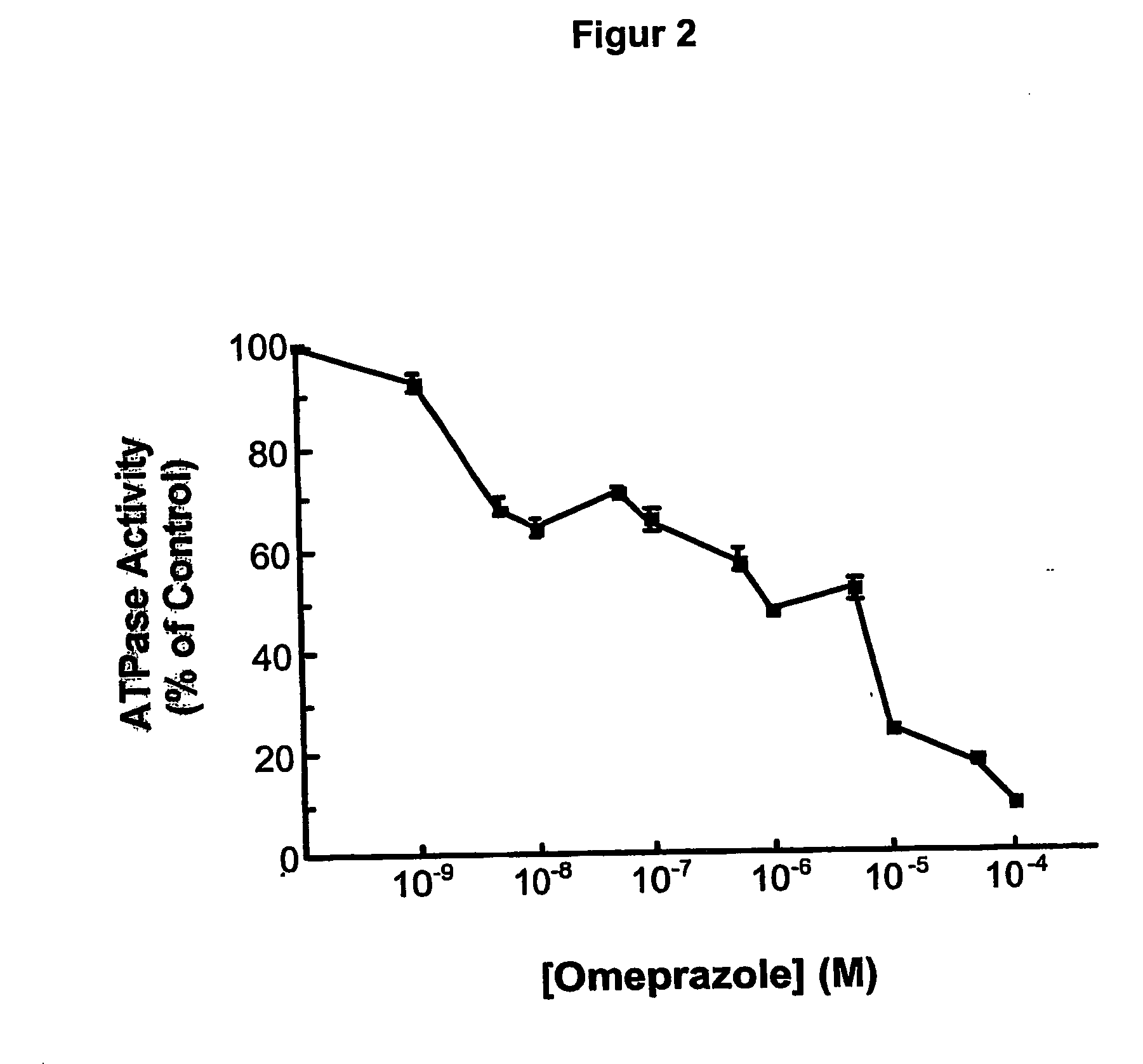Annellated pyrrole compounds as proton pump inhibitors for treating ulcer
a proton pump inhibitor and annellated pyrrole technology, which is applied in the direction of heterocyclic compound active ingredients, biocide, drug compositions, etc., can solve the problems of rapid erosion of the gastric epithelial monolayer and subsequent ulceration of the mucosa, substantial degradation of the active sulfenamide, and decrease of the gastric mucosal blood flow, so as to achieve safe and effective treatment of mammals
- Summary
- Abstract
- Description
- Claims
- Application Information
AI Technical Summary
Benefits of technology
Problems solved by technology
Method used
Image
Examples
example 1
[0138] Effects of ML 3000 on gastric microsomal K+-stimulated, SCH28080-sensitive H,K-ATPase activity.
[0139] Strategy. Microsomal gastric H,K-ATPase was prepared from pig gastric mucosal homogenates by differential centrifugation. Briefly, pig stomachs obtained at a slaughter-house within 1 hour post mortem were washed with ice-cold 0,25 M sucrose and the fundus was dissected from the cardiac and antral regions. All subsequent prodedures were at 4° C. The mucosa was flooded with saturated NaCl, and the surface mucus and superficial cells wiped off with paper towels. The mucosa was scraped from the underlying connective tissue, suspended (10% w / v) in isolation buffer (0,25 M sucrose, 20 mM HEPES, pH 7,4, 1 mM EDTA, 1 mM phenylmethylsulfonyl fluoride), and disrupted by two 10 second bursts at maximum power in a Tissumizer (Tekmar, Cincinnati, Ohio). The homogenate was centrifuged at 20,000 g for 30 minutes, and the supernatant was centrifuged at 105 g for 1 hour. The resulting micros...
example 2
Effects of ML 3000 and other compounds on gastric parietal cell histamine-stimulated acid accumulation.
[0148] Strategy. Gastric parietal cells were isolated from New Zealand White Rabbits by pronase / collagenase digestion of fundic mucosa followed by enrichment of cells on discontinuous Nycodenz gradients in a manner known per se. Aminopyrine accumulation into parietal cells was assessed in 96 well filter plates with Durapore membranes. Briefly, cells were preincubated with [14C]-aminopyrine and then 100,000 cells / 200 μl per well were incubated without or with test compounds for 15 minutes prior to incubation for a further 30 min in the absence or presence of 100 μM histamine. All determinations were performed in quadruplicate. Basal aminopyrine accumulation was determined as aminopyrine accumulation into untreated cells subtracted from accumulation in the presence of KSCN (a reflection of non-specific isotope trapping). Graphical depiction of the data shows percent inhibition of h...
example 3
[0151] Effects of ML 3000 on IL-1β-induced and Heliobacter pylori-induced IL-8 secretion in human gastric adenocarcinoma (AGS) cells.
[0152] Strategy. AGS cells were incubated with test compounds, challanged with IL-1β, and sebsequent secretion of IL-8 into the culture medium was measured by enzyme linked immunosorbent assay; graphical depiction of the data shows precent inhibition od unstimulated or stimulated IL-8 secrretion as a function of a compound concentrations.
[0153] Results. Without stimulation by IL-1β, and in the absence of ML3000 or ZD2138, AGS cells (5×104 in μl culture medium) secreted IL-8 over a period of 6 hr to a concentration of ˜225 μg / ml (FIGS. 17 and 19). When stimulated by IL-1β (20 ng / ml), AGS cell IL-8 secretion over a period of 6 hr was increased ˜27-fold, to a concentration of ˜6000 pg / ml (FIGS. 18 and 20). ML3000 inhibited both baseline (FIG. 17) and IL-1β-stimulated IL-8 secretion (FIG. 18), with IC50 of 0.75 μM and 30 μM repectively.
[0154] The 5-lipo...
PUM
| Property | Measurement | Unit |
|---|---|---|
| Acidity | aaaaa | aaaaa |
Abstract
Description
Claims
Application Information
 Login to View More
Login to View More - R&D
- Intellectual Property
- Life Sciences
- Materials
- Tech Scout
- Unparalleled Data Quality
- Higher Quality Content
- 60% Fewer Hallucinations
Browse by: Latest US Patents, China's latest patents, Technical Efficacy Thesaurus, Application Domain, Technology Topic, Popular Technical Reports.
© 2025 PatSnap. All rights reserved.Legal|Privacy policy|Modern Slavery Act Transparency Statement|Sitemap|About US| Contact US: help@patsnap.com



